Week 7 Lectures 1 (Molecular basis of Neoplasia) and 2 (Cancer Epidemeology) – Flashcards
Unlock all answers in this set
Unlock answersquestion
Neoplasia implies malignancy (T or F)
answer
F. Can be benign or malignant
question
The Molecular basis of neoplasia is
answer
A unifying concept that explains [what gives rise to] tumor cell behavior (benign or malignant) and the influence of 1. Geography (explained below - related to 2 and 3) 2. Culture 3. Environment (explained below) 4. Age (explained below) 5. Heredity (explained below) on causing the genetic damage that leads to cancer.
question
Summary of the Genetic hypothesis of neoplasia
answer
Acquisition of non-lethal genetic damage (mutations) over time that alter normal cell replication.
question
Describes A group of lesions that are based on accumulated genetic events which alter normal replication.
answer
Neoplasia
question
Different ways of genetic damage that can lead to neoplasia
answer
1) Chromosomal breakage 2) Chromosmal translocation (recall the Philadelphia chromsome in CM Leukemia) 3) Point mutations
question
Genetic damage like chromsomal breakage or point mutations can lead to ...................... which can then lead to neoplasia
answer
Absent gene products Abnormal gene products Disordered gene regulation
question
Genetic damage (chromsomal breakage, point mutations) can occur:
answer
1) Spontaneously (age) 2) Due to environmental effects 3) Familial (inherited)
question
Carniogenesis
answer
The initiation of cancer formation from genetic lesions that will underlie a specific form of cancer.
question
Genetic lesions confer an advantage in ............... in abnormal cells vs normal cells. What happens as a result?

answer
The lesions confer replication advantage in abnormal cells compared to normal cells. Because of this advantage, these abnormal cells will then undergo clonal expansion.
question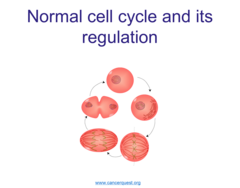
What is meant by cell cycle?

answer
Refers to the cycle during which the cell undergoes temporary expansion and then replication before it gets arrested again in interphase.
question
Cell cycle abnormalities are fundamental to all cancer growths (T or F)
answer
T.
question
Loss of normal cell-cycle control is central to malignant transformation (T or F).
answer
T.
question
Benign neoplasm involves loss of cell cycle control just like in malignant neoplasm. (T or F).
answer
T. Loss of cell-cycle control will lead to abnormal growth whether that growth becomes benign or malignant.
question
Cell proliferation involves what and then what?
answer
DNA replication first and then cell division to distribute the replicated DNA.
question
Cell proliferation Involves a very complex and carefully balanced array of regulatory factors (T or F). Elaborate
answer
T. There are regulatory factors in the cell cycle that allow for Initiation of proliferation when required and cause cessation of proliferation once need is met
question
Note cell proliferation is a very normal process and happens all the time in the body. (T or F) Elaborate.
answer
It is a very normal process. Only when the cell cycle regulation is not controlled that neoplasia can occur which can then lead to problems. It does happen all the time in the body. For example Regeneration (Proliferation) of colonic epithelium after damage due to infection or inflammatory disease or Regeneration of hepatic parenchyma after acute viral hepatitis
question
Steps in normal cell proliferation - Learning objective: Identify the key elements of signal transduction pathways that will lead to gene transcription and ultimately cell replication

answer
1) Damage in any of these steps can hinder replication.
question
Cell differentiation
answer
Cellular acquisition of specialized function For example: Keratin synthesis, lipid synthesis, etc.
question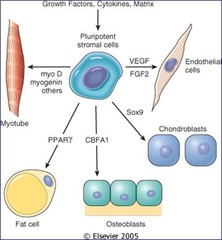
Cell differentiation involves

answer
1) A Precursor stem cell that undergoes 2) Cell replication where specific: 3) Gene expression occurs that cause this cell to be differentiated from other cells.
question
Cell differentiation depends on (will occur after)
answer
Genetic expression occurs in the cell that leads to the differentiation of that cell from other cells.
question
Correlate cell differentiation to cancerous cells.
answer
Since cell differentiaton depends on gene expression, cancer cells can be weirdly differentiated (or may not develop any differentiation at all) because of the genetic damage that precedes carcinogenics.
question
When cells become neoplastic: 1. Cell differentiation is altered 2. Cell proliferation is uncontrolled 3. Specific mutations occur [choose the incorrect answer choice, if any]
answer
All of them are correct.
question
What are proto-oncogenes?
answer
These are NORMAL genes that code for proteins that help regulate cell growth. These important genes are called proto-oncogenes. A change in the DNA sequence of the proto-oncogene can give rise to an oncogene: cancer-causing gene.
question
What are the normal regulatory genes that are involved in normal cell proliferation, etc.
answer
1) Growth-promoting proto-oncogenes 2) Growth-inhibiting tumor suppressor genes 3) Genes that regulate programmed cell death (apoptosis) 4) Genes involved in DNA repair 5) Genes that encode any component along the pathways of cell proliferation
question
Compare Growth-promoting proto-oncogenes with Growth-inhibiting tumor suppressor genes in terms of the effect of mutation of only 1 allele in each gene
answer
1) Mutation of 1 allele for growth-promoting proto-oncogenes is dominant and will lead to problems since this allele is producing more growth-promoting proteins than normal 2) Mutation of 1 allele for growth-inhibiting tumore suppressor genes is recessive and will NOT lead to problems since the normal allele can code for enough proteins to suppress cell-growth. Need mutation in both alleles for problems to occur
question
Learning Objective: List the physiologic alterations on a cellular level that lead to a malignant PHENOTYPE (observable)
answer
1) Self-sufficiency in the absence of growth signals 2) Insensitivity to growth-inhibitory signals 3) Evasion of Apoptosis 4) Defects in DNA repair 5) Limitless replicative potential 6) Sustained angiogenesis 7) Ability to invade and metastasize
question
Which of these statements is/are false 1) Carcinogenesis is a multi-step process, not single event 2) Physiological alterations Differ between cancers, even in the same organ 3) A single mutation or change can fully transform a cell into a cancerous cell
answer
The third statement is false. No single mutation or change can fully transform a normal cell into a cancerous one. Most cancers involve several oncogenes and loss of two or more tumor suppressor genes in order for the cell to become cancerous.
question
Among the physiological alteration in cancer cells is defects in DNA repair. If those defects are inherited that can lead to ............... Explain that
answer
Genomic instability syndromes - DISORDERS that results from mutations (that are inherited) in genes that code for proteins that are involved in DNA repair. These disorders will make the person highly predisposed to cancer.
question
An example of inherited genetic defect is
answer
Xeroderma pigmentosum - inherited disorder due to mutation in the gene that codes for an enzyme involved in nucleotide excision repair (NER) for nucleotides that were damaged due to DNA after UV light exposure => Patients with this disorder have high rates of skin cancer.
question
As the normal cell ages and undergoes more normal DNA replication what happens to telomeres? What does that cause?
answer
telomeres (end of chromsomes) becomes shorter and shorter which causes senescence: loss of cell's ability to divide. This then induces apoptosis.
question
Senescence is
answer
arrest in the cell cycle - cell loses ability to undergo more rounds of replciation because the chromsomes have gotten so short.
question
Telomerase enzyme function
answer
prevents telomeres shortening to prevent replicative senescence and cell aging.
question
In ;90% human tumors, there is increased ............. (hint: enzyme) activity
answer
telomerase, that's why they're able to replicate limitlessly.
question
Discuss sustained angiotensis in cancer cells.
answer
1) No tumor will get bigger over a certain size unelss its able to feed itself. 2) So these tumors cells activate VEGf which can then induce blood vessels to develop and grow inside the tumor so that it can feed itself and get bigger and stronger This is very impormtant to know. Because there is debate on how can you shut off the blood supply to these tumors selectively so that we can only kill the tumor cells.
question
Factor whose release is upregulated to promote sustained angiogenesis for tumor cells
answer
VEGf (Vascular enedothelial growth factor) =; VEGF causes already-existing endothelial cells (that line blood vessels) to first break through existing blood vessels, then migrate towards the signal (i.e. VEGF), grow and replicate and form new blood vessels in the new location as directed by VEGF.
question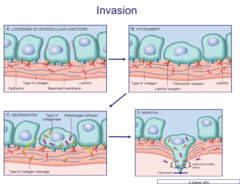
Different ways that cancerous cells are able to invade and metasize

answer
Acquiring of mutations that lead to 1) Altered cell adhesion molecules, e.g., mutation in E-cadherin molecules cause the cells to no longer adhere to another and are able to drift apart. 2) Development of Mutation that leads to turning on of Extracellular matrix degradation enzymes, e.g., collagenase, matrix metalloproteinases so cells can crawl through the tissues
question
Discuss how evasion of apoptosis occurs in tumor cells
answer
For example through Mutation in BCL-2 or p53 genes (discussed below)
question
BCL-2 gene
answer
= normally anti-apoptotic gene In tumor cells, there is alteration or over-expression of that gene that permits tumor cell survival
question
p53 gene
answer
= normally pro-apoptotic gene, In tumor cells, expression is altered/decreased which leadas to tumor cell survival
question
Discuss how Self-sufficiency in the absence of growth signals occurs in tumor cells
answer
Genetic mutations that allow for up-regulation of growth factors, growth factor receptors, signal transduction proteins, nuclear regulatory proteins and proteins involved in cell proliferation that render the tumor cell independent or not needing of external growth signals to proliferate.
question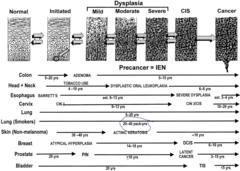
It can take as long as decades for cancer to finally develop (T or F)

answer
T.
question
Why do we care about learning about Cancer?
answer
1) Diagnose which type of cancer 2) Treat through chemotherapy that is eventually getting less toxic and more effective. 3) Knowledge about certain kinds of cancer can help in their Prevention through educating people about and avoiding risk factors as well as regular screening to detect any potentially malignant tumors at an earlier stage.
question
Cancer Incidence: Define Incidence
answer
NEW cases of disease in a specific period in a specific population E.g., Number of people in US with new diagnoses of cancer per year
question
Cancer Prevalence: Define prevalence
answer
All cases of a disease (NEW AnD EXISTING) in a specific period in a specific population E.g., Number of people living with cancer in US per year
question
Incidence and prevalent can be the same (T or F)
answer
T. Incidence and prevalence can be similar because people might not live past one year so prevalence in this case will not increase in number. Recall prevalence is all NEW and EXISTING (people living with cancer) cases. If a specific type of cancer kill in a year (for e.g. year 2014). We're doing our data in 2015: the incidence will be new cases in 2015. Prevalence will be people living with cancer in 2014 AND 2015. But if they were dead in 2014 then in this case prevalence will be identical to incidence.
question
Important Cancer Epidemeology Statistics 1. Top two types of Cancer with highest rate of cancer incidence in men 2. Top two types of Cancer with highest rate of cancer incidence in women 3. Top two types of Cancer with highest rate of death in men 4. Top two types of Cancer with highest rate of death in women
answer
1. Prostate then Lungs (from smoking I assume) - see picture (note:all the others) 2. Breast then Lungs 3. Lungs and then Prostate 4. Lungs and then Breasts
question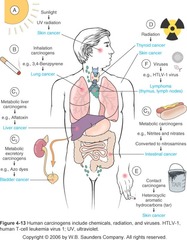
Elements in the Environment that Contribute to Cancer

answer
1) Radiation: UV light, X rays 2) Chemicals/toxins: smoking, foods like hot dogs 3) Viral: e.g. viral lymphoma - see picture
question
Environmental exposure, Age, familal inheritance are all contributers to new cancer in Cancer Epidemology. Geography is not. (T or F)
answer
F. Environmental exposure, Geography, Age and Familial inheritance. Georgraphy: some cases are prevalent in certain parts of the world more than others like in Africa: she said something about higher rates of ovarian/breast cancer due to less access to healthcare.
question
Examples of Radiation
answer
UV light (sun) X rays (like in Chest x rays, atomic bombs)
question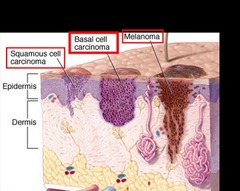
Types of Cancers that can be induced from UV radiation

answer
UV radiation (sun exposure - skin) 1) Melanoma => most serious type of skin cancer => affects melanocytes 2) Squamous cell carcinoma => affects squamous cells: topmost layer of the epidermis 3) Basal cell carcinoma: affects basal cells: bottom-most layer of the epidermis
question
X rays can be produced from

answer
An atomic bomb Nuclear reactor accident (used to "mix nuclei" of atoms to generate isotopes that can be used for various purposes like medical imaging or electricity)
question
Types of Cancer caused by X rays
answer
1) Leukemia - explained below 2) Thyroid carcinoma (expalined below) 3) Breast carcinoma - explained below 4) Colonic carcinoma (just memorize) - third most common cause of death for men and women.
question
Explain how X ray causes thyroid cancer
answer
Iodine gets taken taken up by the thyroid so if you uptake radioactive iodine from X-rays, then you get a rise in the chance of developing thryoid cancer which is really rare otherwise.
question
X-rays and Leukemia
answer
Is the reason why pregnant women shouldn't be exposed to radiation because can induce leukemia in fetus or increases chances of child developing leukemia when he/she grows)
question
X-rays and Breast Cancer
answer
That's why mammograms (x-rays) are not done several times a year.
question
Give examples of Chemical Toxins that can lead to cancer
answer
1) Cigarette smoking (see below) 2) Asbestos [recall the movie Step Brothers] (see below) 3) B-napthylamine (see below) 4) Aflatoxin (see below) 5) Alcohol (see below)
question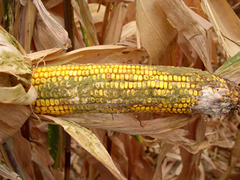
Alfatoxins

answer
Toxins produced by certain fungi that are found on agricultural crops such as (corn) and peanuts: like Alcohol can cause Hepatocellular carcinoma, and esophogeal and gastric cancer.
question
Danger of Cigarette smoking
answer
1) Squamous cell carcinoma of lungs (obvious) also others: (pancreas, breast, bladder [see (2)], etc.) => all p's and b's 2) Contains 2-Naphthylamine which can cause bladder cancer => know this
question
Asbestos causes what

answer
step Brothers - [mesothelioma: malignant tumor of pleura] => what killed Will Ferrell in the movie - lol
question
Alcohol causes what cancers
answer
Hepatocellular carcinoma (obvious - recall Emad - doctor asked if he was Alcoholic) Also others (esophageal, gastric, etc.)
question
Alcohol causes the same types of cancers as
answer
Alfatoxins
question
Discuss the pathogenesis of virus in terms of how it can cause cancer as an environmental agent? Learning Objective: Describe the two mechanisms whereby infection may lead to the development of cancer, and give examples.
answer
1) Integration of viral DNA into human genome, causing genetic damage (altered expression of cell-cycle regulatory genes, damage of tumor suppressor genes, etc.) 2) Chronic infection (like with chronic hepatitis) leading to prolonged (extended) injury and repair, - this also causes and predisposes to genetic damage, and progression to neoplasia - even chronic wounds and burns can lead to that :( :( 3) Produces proteins that can specifically interfere with the cell-cycle :( :( :( (1 and 3) answer the learning objective
question
GERD: how can it cause cancer:
answer
Chronic GERD can cause chronic irritation of the mucosa lining the esophagus due to the acid reflux whic can lead to adenocarcinoma because of the prolonged inflammation and the prlonged injury and repair mechanism associated with this that can then predispose to genetic damage and cancer.
question
Examples of Viruses that Can Cause Cancer
answer
1. HPV Virus (Human papplioma (warts) virus 2. HBV Virus (hepatatis B virus) as well as hepatitis A and C 3. Epstein (Like Klein in Calvin Klein) Barr Virus
question
Related Hepatitis B Virus (HBV) to cancer
answer
Virus causes Acute and chronic infection of liver - Chronic infection predisposes to chronic inflammation whicn can then lead to hepatocellular carcinoma
question
Relate Human Papilloma Virus (HPV) to cancer
answer
Two types of viruses 1) Low risk types = papillomas (warts) 2) High risk subtypes = squamous cell carcinoma (cervix in women - recall HPV positive woman in Dr. Naguib's office), elsewhere)
question
Epstein Barr Virus (EBV) and Cancer
answer
1) Infects B-cells, causes infectious mononucleosis (mono) - (kissing disease) 2) Common infection (;90% US population infected by adulthood) - they do a lot of kissing - lol 3) Related to some types of B-cell neoplasms like leukemias/lymphomas.
question
Virus that lives inside white blood cells and can cause problems when you're immunosuppressed like during an organ transplant
answer
Epstein Barr virus:
question
Virus that all of us are latently infected by it
answer
Epstein Barr Virus.
question
The way geography causes cancer is because lattitudal differences across the globe contribute to specific types of cancers. (T or F).
answer
F. Latitude has nothing to do with cancer. The reason why certain cancers are more prevalent in certain geographical areas is often reflection of the ENVIRONMENTAL or cultural practices in that region.
question
Learning Objective: Explain the influence of geography on the development of cancer - which regions (developing vs developed) is the prevalence of each of these cancers more prevlanet: 1) Cervical Cancer 2) Lung Cancer 3) Breast Cancer 4) Stomach Cancer
answer
1) More prevalence in certain types of cancer in all parts of the world. a) Cervical cancer more prevalent ind developing countries like Africa due to high rates of HIV which predisposes to higher chance of HPV infection. b) Lung cancer is more prevalent in developing countries than developed countries where we have anti-smoking campaigns in developed world but not in developing world, c) Breast cancer or prostate cancer: more prevalent in developed countries d) Stomach cancer: more prevalent in developing countries (possibly because of dirty water)
question
Most cancer mortality occurs between ages ........... why?
answer
55-75; By that time enough genetic damage has accumulated to cause cancer and malignancy.
question
Relate Age to Cancer
answer
As one ages there is accumulation of genetic damage due to accumulation of environmental damage and spontaneous errors during replication as well as imbalance between damage and repair
question
Learning Objective: Explain the molecular mechanisms behind an inherited predisposition to cancer,
answer
"One strike against the person" - Person inherits a defective allele in a gene that codes for proteins that are important cell cycle regulators in that particular tissue or organ. This markedly increases his/her chance of developing a certain kind of cancer - like Dr. Nabil and Father ????? ????: they're both blind because it runs in their family but Dr. Nabil didn't pass it to his children.
question
Learning Objective: Give examples of certain kinds of cancer that involve familial/inherited predisposition.
answer
1) Retinoblastoma (RB gene) - Dr. Nabil Soliman 2) Familial adenomatous polyposis of colon (APC - adenomatous polyposis of colon gene) - Lynch Syndrom 3) Colon carcinoma (HNPCC) 4) Breast carcinoma (BRCA1 and BRCA2 genes) 5) Xeroderma pigmentosum (from last lecture - inherited defect in the NER that codes for the enzyme that repairs DNA through nucleotide exciison repair after sunlight exposure - defect markedly increases chances of skin cancer)
question
Lynch Syndrome is synonymous with
answer
Familial adenomatous polyposis of colon - caused due to an inherited defect in a gene that is an important cell-cycle regulator in colorectal (colon) cells.
question
Familial .................................. poly.................... of the colon different from
answer
adenomatous; posis; colon carcinoma
question
Why aren't we all overrun in tumors?
answer
1) Genetic lesions: Usually repaired (many robust mechanisms) 2) If not repaired, lethal to cell (which is great), or apoptosis usually induced Hence problem occurs when there is a genetic damage that is NOT repaired, the cell survives it and then those lesions affect the cell-cycle regulation.
question
To lead to neoplasia, cell must ................. the lesion and the lesion must affect
answer
to lead to neoplasia, cell must survive the genetic lesion (doesn't undergo apoptosis) [that couldn't be repaired] AND the lesion must affect cell cycle regulation
question
Learning Objective: • Describe the mechanisms in the body that normally prevent the development of neoplasia
answer
1. Repair of damaged DNA 2. If couldn't be repaired, cell dies or is induced to undergo apoptosis for example through the white blood cells (phagocytes) of the immune system.
question
Learning Ojbective: Explain how molecular methods may be used in the diagnosis of cancer
answer
1) Visual examination of cells and tissue under the microscope (we can assign grading and sometimes observe the stage of cancer progression) 2) Detection of specific cancer proteins: we use special stains that will color code proteins that will be over-expressed in cancer - see below
question
Describe what visual examination of cells and tissues under the microscope has to offer with respect to cancer diagnosis
answer
a) We can observe Histology and cytology of the the cells and see if they're cancerous (have special features) b) Give Grading (of how differentiated the tumor cell is) and (some) staging sometimes for accurate more detailed diagnosis
question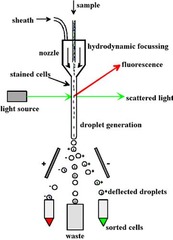
How do we detect cancer proteins.

answer
1) Immunocytochemistry or Immunohistochemistry (detection of cancer protein by using antibodies) 2) Flow cytometry: see picture: you study physical and chemical properties of PROTEINS as they pass through a laser - see if they're cancerous 3) Tumor markers: substances produced by cancer cells -indicate that the cancer is still present; they're mostly proteins
question
Immunocytochemistry is the same thing as
answer
immunohistochemistry
question
Immunocytochemistry: Uses
answer
We use antibodies to bind to the protein of interest (the cancer protein). This help us in 1) Categorization of undifferentiated tumors like in leukemia or lymphomas - see 2) 2) Determination of origin of metastatic tumors (especially the undifferentiated ones) - because they will express "wierd" proteins that help us identify the origin of the cancer. 3) Detection of significant molecules that help us predict the cancer prognosis (overexpression of the growth factor receptor called HER-2 in breast cancer)
question
Cell surface antigens, cytoplasmic proteins, enzymes, hormones that are biochemical indicators of presence of tumor detected in plasma or body fluids. These can all be referred to as
answer
Tissue markers
question
It is sufficient to make cancer diagnosis based on detection of tumor markers. (T or F).
answer
F. Presence of tumor markers alone not sufficient for diagnosis (these markers are sometimes found in benign diseases) - Most not sensitive or specific enough for screening. They're better used to detect if the treatment went well, absence of tumor markers maens treatment went very well.
question
Can be used to detect how well the cancer treatment went, if it still in the blood or if it is really high then treatment might not be working.
answer
Tumor Markers
question
Function(s) of Tumor markers
answer
1. Help confirm diagnosis that are cancer cells present (has to be used with other methods though) 2. Help us know if the treatment is working well.
question
What is the importance understanding the molecular basis of cancer [stupid slide]
answer
1) Diagnosis of cancer at molecular level 2) Identify most appropriate therapy: Design chemotherapy that is effective and less toxic (like Gleevec, Herceptin, etc) 3) Prevention of cancer through avoidance of risk factors (discussed below) 4) Screening for early cancer (like in mammograms) and precursor lesions 5) Classification for prognosis (based on what we observe molecularly) and Evaluating for residual disease after treatment 6) Monitor for relapse even after removal of any residual cancerous cells.
question
What are the detection methods to detect genetic damage at chromosmal, subchromosmal, single mutation or gene expression level?
answer
1) Chromosomal level => Cytogenetics 2) Sub-chromosomal: translocations, large deletions/insertions, gene amplification => FISH method 3) Single mutations, small insertions, deletions => PCR 4) Patterns of gene expression => Array analysis (genetic vs proteomics) => explained below.
question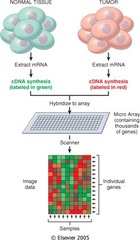
Molecular diagnosis: Arrays

answer
Since Neoplasia is a multi-step process, with multiple abnormalities, we move away from thinking of single genes toward patterns of gene expression, proteins - Don't need to know picture
question
Method to look at Profiles of Gene expression in a tumor vs normal cell
answer
Microarray
question
Method to look at patterns of protein expression in a tumor vs normal cell
answer
Proteomics
question
Name of monoclonal Ab we administer against HER2 (amplified gene that codes for growth factor receptor - amplification increases chance for breast cancer)
answer
Herceptin
question
Growth factor receptor in breast cancer
answer
HER2
question
Gene amplified in breast cancer, ovarian cancer
answer
HER2 gene
question
A drug that is tyrosine kinase inhibitor (used to treat CML)
answer
Gleevec - will inhibit the tyrosine kinase receptor that is specific to CML - great drug.
question
Gleevec is used to treat (hint 2 diseases)
answer
CML Gastrointestinal stromal tumors
question
How does molecular diagnostic tools help in cancer prevention?

answer
1) Earlier, more frequent screening can help identify different cancers like detection of early tumors. 2) Using these molecular tools can help us identify if person has the defective gene so we can advice person to avoidance factors that can precipiate carcinogenesis. For example: Xeroderma pigmentosum (avoidance of UV exposure) [relevant to #4] 3) Prophylactic surgery like in the case of Familial polyposis syndromes (colectomy) and Some hereditary breast carcinoma syndromes (mastectomy - Angelina Jolie) 4) Avoidance or removal of inciting agent (discussed below)
question
Molecular diagnostic tools that detect defective genes help us avoid or remove inciting agents - give examples of physical, chemical and viral carcinognes and how we can avoid or remove them
answer
1) Physical carcinogens a) Sun exposure (clothing, sunscreen) b) Radiation: radiation safety 2) Chemical carcinogens a)Lifestyle changes (quit cigarette smoking, alcohol) b) Occupational health and safety (limit exposures of workers) c) Environmental stewardship (appropriate disposal of carcinogens) 3) Viral agents HPV: safer sexual practices, vaccine HBV: avoidance of exposure, vaccine, treatment
question
Learning Objective: Define and describe the purpose of cancer screening.
answer
Identify premalignant lesions and/or early malignant lesions for treatment and/or removal prior to invasion and metastasis
question
Examples of Cancer Screening Methods
answer
1. Screening through Pap smear (cervical dysplasia and carcinoma) - The sample of cells from your cervix will be preserved and sent to a lab to be tested for the presence of abnormal cells. 2. Screening through Colonoscopy (colon adenoma and carcinoma) 3. Screening through Mammogram (breast carcinoma)
question
What is usually done with a Pap smear
answer
HPV testing - because you want to do full screening for cercvial cancer. HPV can cause cervical cancer so that's why we screen for that too.
question
Screen for cervical carcinoma
answer
PAP smear
question
How frequently is pap smear done
answer
Annually after initiation of sexual activity or after age 21
question
Screen for breast cancer
answer
Mammograms
question
Screen for colon cancer
answer
Colonoscopy
question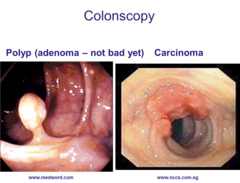
Premalignant tumors (colon cancer)

answer
Before development of colon cancer: you have a development of a little polyp that doesn't become malignant until 15 or 20 years later. Hence colonoscopy is important so that the doctor can check for the presence of polyps and pull them out as necessary.
question
How often is colonsocopy done?
answer
Every 3-5 years beginning at age 50
question
In screening for colon cancer, colonscopy can be accompannied by anotehr test. What is it?
answer
Fecal occult blood test: Test for occult (hidden, not readily discernible) blood in stool annually after age 50
question
Does cancer arise from a somatic or germline mutation?
answer
Cancer usually occurs due to mutations in somatic cells. However, less frequently it can also occur due to mutations due to an egg or sperm cell and in this case it can be inherited.



